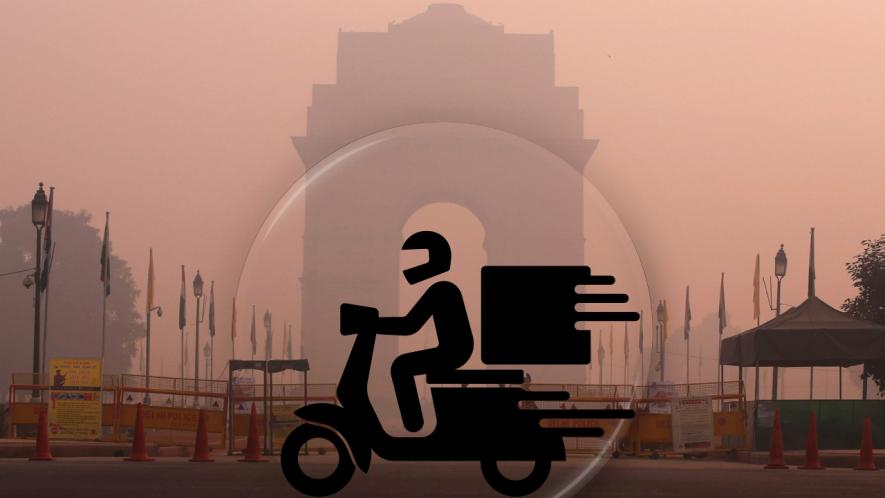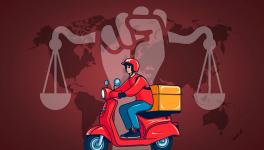Gig Workers Amid Rising Air Pollution

Delhi’s deteriorating air quality has made the Air Quality Index (AQI) a much more troubling concern than any other numerical measure. The falling AQI unveils reflects the asymmetrical impact of adversities, particularly the most significant threat to livelihoods. Poor AQI levels trigger health issues, impact workforce productivity, increase healthcare costs, and profoundly impact the ability to make a living. As the AQI breached the ominous 400 mark in early November, the city reached a point where it could no longer ignore the effects of air pollution on lower income households. Arguably, those tethered to the platform or gig economy, are profoundly impacted by the toxic air pollutants all around. The harsh reality is that escalating pollution bears down more heavily on the vulnerable, thus amplifying existing economic and social disparities.
The gig economy is a labour market characterised by short-term, flexible jobs, often facilitated through digital platforms or apps. Workers in the gig economy, commonly known as gig workers or freelancers, are not traditional full-time employees but individuals who take on temporary or project-based tasks. Examples include ride-sharing drivers, food delivery couriers, freelance writers, and graphic designers.
Gig economy workers typically have the ‘flexibility’ to choose when and where they work, and the majority lacks job security, employee benefits, and legal protections from traditional employment. In turn, technological advancements have raised the demand for gig workers, enlarging the gig economy.
However, within this segment, incomes vary based on the type of gig, skill level, and the demand for particular services. High-income gig workers are skilled software development, graphic design, or consulting professionals. These workers are often associated with specialised projects or provide high-demand services. Their work has the potential for substantial earnings due to expertise and experience. Then there are middle-income gig workers who work in individual roles such as freelance writing, marketing, or web development. Though they offer valuable skills, they do not command the same rates as the specialised professionals. However, they make a decent income depending on the demand and the ability to secure consistent gigs.
Low-income gig workers fall in the entry-level or less-skilled gig roles, like delivery drivers, basic data entry, or micro-task workers. These workers often face intense competition and may earn less per gig, and must rely on completing a high volume of tasks for sustainable income.
Then there are variable-income gig workers, who include workers in ride-sharing, food delivery, or other on-demand services. Here, incomes can change based on demand, time spent working, and location. By and large, their incomes are unstable. Finally, an entire class of platform owners and aggregators own or operate gig platforms who derive their income from all these categories of gig workers through fees, commissions, or subscriptions of varied models. They may have a high income potential depending on the success and scale of the platform. It is important to note that individual circumstances, market conditions, and regional variations contribute significantly to the income diversity within the gig economy.
But all this diversity comes to naught when it comes to the basic circumstances of work—there is a dichotomy within the gig economy in terms of whether workers are engaged in low-income tasks or at the highest level. The air pollution crisis is a stark illustration of this dichotomy. The lowest-earning gig workers fulfil their commitments—delivery drivers, micro-task workers, couriers and others—cloaked the ominous toxic smog. But it is not just that they inhale polluted air. This pollution is also a direct assault on their livelihoods.
The poor air quality is their unseen and silent adversary, undermining their ability to meet their work commitments and plunging them into a vortex of direct income losses. The tale takes a heart-wrenching turn for those on the lower rungs of the gig economy ladder. Stripped of traditional employment benefits such as health insurance, these workers are on the precipice of financial ruin when health issues arise from prolonged exposure to the city’s toxic air. A brutal compromise in their living standards is the bitter reality of every breath they take.
The elite gig workers are among a privileged few with the means to relocate at will. They can escape Delhi’s polluted embrace without denting their substantial incomes. The remedy is simple for those who choose to stay: air purifiers strategically placed in residences, offices, even vehicles, creating a bubble of clean air in their privileged world. This is where the script takes another chilling turn. The low-income gig workers are trapped and unable to migrate unless they sacrifice a significant chunk of their hard-earned incomes. The very act of trying to earn a living makes their health a collateral victim in this unequal battle.
In this saga of declining air quality, we get a tale of two worlds within one city, whose protagonists grapple with the challenges of gig life with an invisible foe that threatens their existence. Welcome to the cityscape drama where every gig worker is a character in a narrative shaped by the merciless hand of pollution.
Rising hazardous air pollution, disproportionately felt by the poor and marginalised, underscores the urgent need for targeted interventions and policies to overcome the divergence in resilience and coping mechanisms. We must protect the vulnerable, ensuring that the burden of environmental challenges is not disproportionately shouldered by those who already face economic hardships.
Crafting an effective strategy to combat air pollution demands we intricately account for socio-economic disparities. In the pursuit of cleaner air, policy initiatives should target environmental concerns and prioritise the health and livelihoods of the most marginalised in society. A nuanced and comprehensive policy framework is essential to ensure equitable outcomes and address the pressing challenges of air pollution on collective well-being.
First and foremost, implementing and enforcing environmental regulations targeting industries in pollution-prone areas is essential. These regulations should be designed to significantly reduce overall pollution levels, addressing the root causes.
Urban planning policies are crucial in mitigating pollution exposure, particularly for lower-income communities. Zoning regulations can restrict industrial activities near residential areas while promoting the creation of green spaces. This strategic urban planning can create healthier living environments for vulnerable populations.
Governments must prioritise investments in public transportation infrastructure to reduce the reliance on personal vehicles. By enhancing and expanding public transportation options, authorities can curb emissions and contribute to overall air quality improvement.
Community-based health programs are of paramount importance for prevention, early detection, and management of health issues related to air pollution. Mobile health clinics, awareness campaigns, and improved accessibility to healthcare facilities are integral components of this approach.
Addressing the economic ramifications of pollution is equally essential. Policymakers should develop social safety nets and job transition programs tailored to support workers, particularly those in lower-income brackets, employed in high-pollution industries. This would ensure that the burden of economic shifts resulting from pollution reduction measures is equitably managed.
Incentivising the adoption of cleaner technologies is a proactive measure. Governments can consider providing incentives, subsidies, or tax breaks for businesses and individuals embracing environment-friendly practices. This would support economic transitions and help improve public health.
Incorporating environmental justice principles into policymaking is crucial for ensuring fair distribution of environmental benefits and burdens. By centring decision-making around equity, policymakers can work towards alleviating disparities and fostering inclusive environmental policies.
Any equitable approach to addressing air pollution requires a combination of these policy measures. By integrating stringent environmental regulations, strategic urban planning, investments in public transportation, and community-focused health programs, with incentives for cleaner technologies, governments can safeguard the well-being of all citizens, particularly the marginalised. Incorporating environmental justice principles would ensure that pollution reduction benefits are shared equitably among diverse communities. Through collaborative efforts and a commitment to these policy measures, policymakers can pave the way for a cleaner, healthier, and more inclusive future.
The authors are associate professors at the Zakir Husain Delhi College, University of Delhi. The views are personal.
Get the latest reports & analysis with people's perspective on Protests, movements & deep analytical videos, discussions of the current affairs in your Telegram app. Subscribe to NewsClick's Telegram channel & get Real-Time updates on stories, as they get published on our website.






















